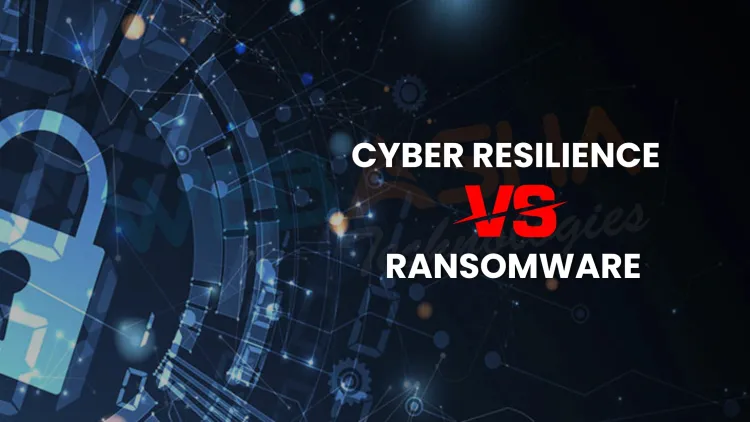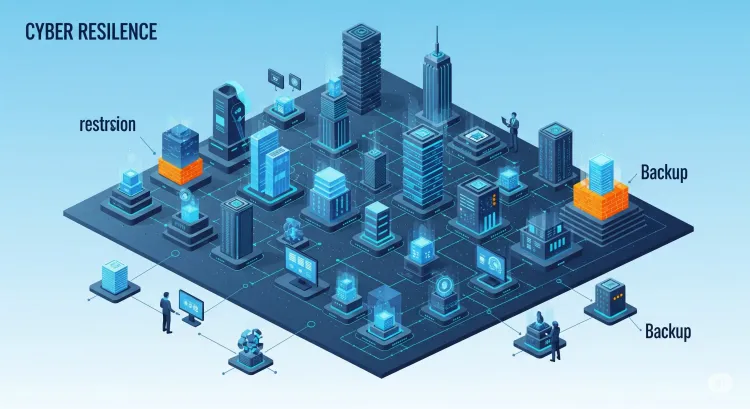What is the importance of cyber resilience in the age of ransomware? The Detailed Guide
In the age of ransomware, simply having backups is not enough. Cyber resilience ensures that an organization can withstand and recover from cyberattacks without major disruption. Unlike traditional backup strategies that focus on restoring data post-incident, cyber resilience integrates real-time threat detection, immutable storage, fast recovery, and Zero Trust security principles. With ransomware attacks becoming more sophisticated—often involving data theft, backup deletion, and double extortion—IT leaders must rethink their approach. Cyber resilience enables proactive defense, minimizes downtime, protects brand reputation, and ensures business continuity.

Table of Contents
- What Is Cyber Resilience and How Is It Different from Backup?
- Why Backup Alone Fails Against Modern Ransomware
- The Ransomware Evolution: Why IT Leaders Must Act
- Key Pillars of Cyber Resilience
- Real-World Impact: Backup vs. Resilience
- Moving from Reactive to Proactive
- Conclusion
- Frequently Asked Questions (FAQs)
In today's threat landscape, traditional data backup is no longer enough. As ransomware grows more advanced and frequent, IT leaders must shift from a mindset of “backup and restore” to one of cyber resilience—the ability to withstand, recover from, and adapt to cyberattacks. This blog explores why this shift is essential, how ransomware is changing the rules, and what strategies leaders must adopt to ensure true business continuity.
What Is Cyber Resilience and How Is It Different from Backup?
Backup is a component of resilience—but not the whole story. Backups store copies of data, while cyber resilience ensures that your organization can continue operating even during an ongoing attack. It includes proactive defense, rapid recovery, detection, incident response, and continuity planning.
While a backup helps you restore data after an incident, cyber resilience helps you minimize the impact of the attack in real time and recover operations faster, without prolonged downtime or data loss.

Why Backup Alone Fails Against Modern Ransomware
Modern ransomware doesn't just encrypt files—it exfiltrates data, deletes backups, targets hypervisors, and spreads laterally across systems. Here are ways traditional backup strategies fall short:
-
Backup deletion: Attackers often gain admin access and delete backup copies before encryption.
-
Data exfiltration: Sensitive files are stolen and used for double extortion, rendering backups useless.
-
Slow recovery: Even with backups, restoring terabytes of data can take days.
-
Corrupted or encrypted backups: If the malware remains undetected for weeks, it may have infected backup files as well.
Relying solely on backup creates a false sense of security. What’s needed is an integrated cyber resilience approach.
The Ransomware Evolution: Why IT Leaders Must Act
Ransomware attacks have become industrialized. Some key trends include:
| Attack Vector | Modern Trend | Risk to Organizations |
|---|---|---|
| Ransomware-as-a-Service (RaaS) | Cybercriminals sell attack kits | More frequent, scalable attacks |
| AI-Driven Phishing | Spear phishing using deepfakes | Harder to detect socially engineered threats |
| Double/Triple Extortion | Encrypt + exfiltrate + threaten | High reputational and compliance risk |
| Supply Chain Attacks | Compromised vendors | Wider impact, hard to trace |
The speed and sophistication of ransomware now outpace traditional defenses. IT leaders must respond by embedding resilience across people, process, and technology.
Key Pillars of Cyber Resilience
To build cyber resilience, organizations must focus on five essential pillars:
1. Immutable and Air-Gapped Backups
Ensure that backups cannot be altered or deleted, even by administrators. Use air-gapped or object-locked storage with versioning and encryption.
2. Continuous Threat Detection
Use EDR/XDR tools, network anomaly detection, and AI-based monitoring to identify threats early—before ransomware spreads.
3. Zero Trust Architecture
Implement Zero Trust principles: never trust, always verify. Authenticate all access, segment networks, and apply least privilege access.
4. Fast, Orchestrated Recovery
Use automation and orchestration to recover systems and data quickly. Consider instant recovery or live mount features that reduce downtime.
5. Regular Testing and Simulation
Conduct regular disaster recovery (DR) drills, ransomware simulations, and red teaming exercises to ensure recovery processes actually work.
Real-World Impact: Backup vs. Resilience
Imagine two companies attacked by ransomware:
-
Company A relied on scheduled daily backups stored on the same network. The attacker encrypted their data and backups. They spent 12 days offline.
-
Company B had immutable cloud backups, segmented networks, and automated failover systems. They restored operations in 2 hours, with minimal impact.
Which one would you rather be?
Moving from Reactive to Proactive
Cyber resilience isn’t just about defense. It’s about preparedness, speed, and adaptability. IT leaders must collaborate with security teams, business units, and vendors to implement:
-
Real-time monitoring and response
-
Automated patching and endpoint hardening
-
Clear incident response plans
-
Staff awareness and phishing simulations
Conclusion
The age of ransomware demands a new mindset. Backups are necessary but not sufficient. IT leaders must shift to resilience-first strategies that combine smart architecture, real-time defense, and recovery automation.
Cyber resilience is no longer a luxury—it’s a necessity. In a world where ransomware is not a question of "if" but "when", resilience determines who survives and who doesn’t.
Stay resilient. Stay ready. Stay in business.
FAQs
What is cyber resilience?
Cyber resilience refers to an organization’s ability to continuously deliver intended outcomes despite cyberattacks or IT disruptions.
How is cyber resilience different from traditional backups?
Traditional backups store copies of data, while cyber resilience ensures quick recovery, real-time defense, and business continuity during and after cyberattacks.
Why are traditional backups not enough to stop ransomware?
Modern ransomware can delete backups, exfiltrate data, and corrupt backup files. Relying on backups alone may result in extended downtime and data loss.
What are immutable backups?
Immutable backups are write-once, read-many storage systems where data cannot be altered or deleted, protecting against ransomware tampering.
What is an air-gapped backup?
An air-gapped backup is isolated from the network, making it inaccessible to attackers even if they gain control of the primary systems.
What is Zero Trust, and how does it help in ransomware defense?
Zero Trust is a security model that assumes no user or system is trusted by default. It enhances ransomware defense by enforcing strict access controls.
How can automation improve ransomware recovery?
Automation enables faster, more accurate restoration processes, minimizing human error and reducing downtime after an attack.
What is the role of threat detection in cyber resilience?
Real-time threat detection helps identify and mitigate ransomware threats before they spread or cause significant damage.
Can ransomware infect backup systems?
Yes, if backups are not isolated or protected, ransomware can encrypt or delete them, rendering them useless during recovery.
What are the benefits of ransomware simulations?
Simulations test your response plans and resilience under attack, helping you identify weaknesses before a real incident occurs.
How fast should recovery be after a ransomware attack?
Ideally, critical systems should be restored within minutes to a few hours, depending on the recovery time objective (RTO).
What is EDR/XDR in cyber resilience?
Endpoint Detection and Response (EDR) and Extended Detection and Response (XDR) are tools that provide real-time monitoring and response to threats across devices and systems.
How often should backups be tested?
Backups should be tested regularly—at least quarterly—to ensure they are complete, functional, and capable of rapid recovery.
What is the cost of downtime caused by ransomware?
Downtime can cost thousands to millions of dollars per hour, depending on the organization’s size and industry.
Should backups be stored in the cloud?
Yes, cloud-based immutable backups with versioning and geo-redundancy offer high availability and security against ransomware.
Can AI help in ransomware detection?
Yes, AI-powered tools can detect anomalies in behavior, identify suspicious file encryption activity, and respond faster than manual monitoring.
What is business continuity in cyber resilience?
It refers to the organization’s ability to maintain essential operations during a cyber crisis through planning, redundancy, and fast recovery.
How do you create a cyber resilience strategy?
It includes risk assessments, Zero Trust implementation, backup security, recovery automation, and incident response planning.
What is ransomware double extortion?
Double extortion is when attackers not only encrypt your data but also exfiltrate it and threaten to leak it if ransom is not paid.
Can ransomware spread across a network?
Yes, ransomware often spreads laterally across networks using stolen credentials or vulnerabilities in unpatched systems.
What is the importance of segmentation in cyber resilience?
Segmentation helps contain attacks by isolating systems and limiting the spread of malware across networks.
How can phishing simulations help?
They train employees to recognize and avoid social engineering attacks, reducing the chances of initial ransomware infection.
What are ransomware playbooks?
Playbooks are predefined response plans outlining actions, responsibilities, and timelines for ransomware incidents.
How does fast recovery support compliance?
Quick recovery reduces data loss and helps meet regulatory requirements like GDPR, HIPAA, and ISO 27001.
What are live mount and instant recovery?
These technologies allow organizations to restore systems directly from backups, minimizing recovery time.
What’s the role of DR drills in resilience?
Disaster Recovery (DR) drills validate that backup and recovery systems work as intended, ensuring preparedness.
Can small businesses benefit from cyber resilience?
Yes, even small businesses face ransomware risks and should implement scalable resilience strategies.
How do supply chain attacks impact resilience?
If a vendor is compromised, attackers may enter your environment, making third-party risk assessments crucial.
How should IT leaders prioritize resilience?
Start with risk assessment, protect backups, implement Zero Trust, test recovery, and educate staff.
Why is cyber resilience a business issue, not just IT?
Cyberattacks impact reputation, revenue, and operations—making cyber resilience critical at the executive level.
How can organizations get started with resilience?
Begin by assessing current gaps, protecting backups, investing in detection and recovery tools, and building a tested incident response plan.














![Top 10 Ethical Hackers in the World [2025]](https://www.webasha.com/blog/uploads/images/202408/image_100x75_66c2f983c207b.webp)








